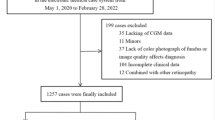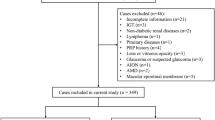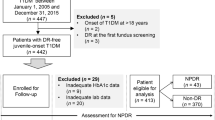Abstract
Aims
Diabetic retinopathy is the leading cause of blindness in people with type 2 diabetes. To enable primary care physicians to identify high-risk type 2 diabetic patients with diabetic retinopathy at an early stage, we developed a nomogram model to predict the risk of developing diabetic retinopathy in the Xinjiang type 2 diabetic population.
Methods
In a retrospective study, we collected data on 834 patients with type 2 diabetes through an electronic medical record system. Stepwise regression was used to filter variables. Logistic regression was applied to build a nomogram prediction model and further validated in the training set. The c-index, forest plot, calibration plot, and clinical decision curve analysis were used to comprehensively validate the model and evaluate its accuracy and clinical validity.
Results
Four predictors were selected to establish the final model: hypertension, blood urea nitrogen, duration of diabetes, and diabetic peripheral neuropathy. The model displayed medium predictive power with a C-index of 0.781(95%CI:0.741–0.822) in the training set and 0.865(95%CI:0.807–0.923)in the validation set. The calibration curve of the DR probability shows that the predicted results of the nomogram are in good agreement with the actual results. Decision curve analysis demonstrated that the novel nomogram was clinically valuable.
Conclusions
The nomogram of the risk of developing diabetic nephropathy contains 4 characteristics.
that can help primary care physicians quickly identify individuals at high risk of developing DR in patients with type 2 diabetes, to intervene as soon as possible.







Similar content being viewed by others

Data availability
The data used to support the findings of this study are available from the corresponding author upon request.
Abbreviations
- T2DM:
-
Type 2 diabetes mellitus
- DR:
-
Diabetic Retinopathy
- DN:
-
Diabetic nephropathy
- DPN:
-
Diabetic peripheral neuropathy
- ROC:
-
Receiver operating characteristic
- DCA:
-
Decision curve analysis
- BMI:
-
Body mass index
- HbA1c:
-
Glycosylated hemoglobin A1c
- Scr:
-
Serum creatinine
- BUN:
-
Blood urea nitrogen
- LDL-C:
-
Low-density lipoprotein
- HDL-C:
-
High-density lipoprotein
- TC:
-
Total cholesterol; TG: triglycerides
- IGF-1:
-
Insulin-like growth factor-1
- IGFBP-3:
-
Insulin-like growth factor binding protein-3
- FBG:
-
Fasting blood glucose
- OR:
-
Odds ratio
- MDRD:
-
Modification of diet in renal disease
References
Guo Z, Priefer R (2021) Current progress in pharmacogenomics of Type 2 diabetes: a systemic overview[J]. Diabetes Metab Syndr 15(5):102239
Joshi RD, Dhakal CK (2021) Predicting Type 2 Diabetes Using Logistic Regression and Machine Learning Approaches[J]. Int J Environ Res Public Health 18(14):7346
Yoon J, Oh IH, Seo H et al (2016) Disability-adjusted life years for 313 diseases and injuries: the 2012 Korean burden of disease study[J]. J Korean Med Sci 31(Suppl 2):S146–S157
Yau JWY, Rogers SL, Kawasaki R et al (2012) Global prevalence and major risk factors of diabetic retinopathy.[J]. Diabetes care 35(3):556–564
The EDPR (2004) The Prevalence of diabetic retinopathy among adults in the united states[J]. Arch Ophthalmol 122(4):552–563
Pang C, Jia L, Jiang S et al (2012) Determination of diabetic retinopathy prevalence and associated risk factors in Chinese diabetic and pre-diabetic subjects: shanghai diabetic complications study.[J]. Diabetes/metabm Res Rev 28(3):276–283
Xu J, Wei WB, Yuan MX et al (2012) Prevalence and risk factors for diabetic retinopathy: the Beijing communities diabetes study 6.[J]. Retina (Philadelphia, Pa.) 32(2):322–329
Koziol M, Nowak MS, Udziela M et al (2020) First nation-wide study of diabetic retinopathy in Poland in the years 2013–2017[J]. Acta Diabetol 57(10):1255–1264
Jinan BS, Amanda AH, VenkatZhang KM et al (2008) Projection of diabetic retinopathy and other major eye diseases among people with diabetes mellitus: united states, 2005–2050[J]. Archives of Ophthalmology 126(12):1740–1747
Kashif M, Rohit V, Farzana C et al (2011) Severity of diabetic retinopathy and health-related quality of life[J]. Ophthalmology 118(4):649–655
Zhang G, Chen H, Chen W et al (2017) Prevalence and risk factors for diabetic retinopathy in China: a multi-hospital-based cross-sectional study.[J]. British j ophthalmol 101(12):1591–1595
Alberti KG, Zimmet PZ (1998) Definition, diagnosis and classification of diabetes mellitus and its complications Part.1: diagnosis and classification of diabetes mellitus provisional report of a WHO consultation[J]. Diabet Med 15(7):539–553
Jalalonmuhali M, Lim SK, Md SMN et al (2017) MDRD vs. CKD-EPI in comparison to 51Chromium EDTA: a cross sectional study of Malaysian CKD cohort.[J]. BMC nephrol 18(1):1–6
Tien Y W, Chui M G C, Michael L, et al. (2016) Diabetic retinopathy.[J]. Nat Rev Disease prim 2(1).
Wei L, Bo X, Shanhu Q et al (2018) Non-lab and semi-lab algorithms for screening undiagnosed diabetes: a cross-sectional study[J]. EBioMedicine 35:307–316
Yin L, Zhang D, Ren Q et al (2020) Prevalence and risk factors of diabetic retinopathy in diabetic patients: a community based cross-sectional study[J]. Med (Baltimore) 99(9):e19236
Tien YW, Ronald K, Amirul FM et al (2005) Diabetic retinopathy in a multi-ethnic cohort in the united states[J]. Am J Ophthalmol 141(3):446–455
Xie XW, Xu L, Wang YX et al (2008) Prevalence and associated factors of diabetic retinopathy The Beijing eye study 2006 [J]. Gra Arch clin exp ophthalmol 246(11):1526
Rajalakshmi R, Amutha A, Ranjani H et al (2014) Prevalence and risk factors for diabetic retinopathy in Asian Indians with young onset type 1 and type 2 diabetes[J]. J Diabet Complicat 28(3):291–297
Varma R, Macias GL, Torres M et al (2007) Biologic risk factors associated with diabetic retinopathy: the los angeles latino eye study[J]. Ophthalmology 114(7):1332–1340
Sun Q, Jing Y, Zhang B, et al. (2021) The Risk Factors for Diabetic Retinopathy in a Chinese Population: A Cross-Sectional Study[J]. Journal of Diabetes Research 2021.
Cui Y, Zhang M, Zhang L et al (2019) Prevalence and risk factors for diabetic retinopathy in a cross-sectional population-based study from rural southern China: dongguan eye study.[J]. BMJ Open 9(9):e023586
Singh HV, Das S, Deka DC et al (2021) Prevalence of diabetic retinopathy in self-reported diabetics among various ethnic groups and associated risk factors in north-east India: a hospital-based study [J]. Indian J Ophthalmol 69(11):3132
Pang C, Jia L, Hou X et al (2014) The significance of screening for microvascular diseases in Chinese community-based subjects with various metabolic abnormalities.[J]. PloS one 9(5):e97928
Ramachandran R, Anandakumar A, Harish R et al (2014) Prevalence and risk factors for diabetic retinopathy in Asian Indians with young onset Type 1 and Type 2 Diabetes[J]. J Diabetes Its Complicati 28(3):291–297
Christy LA, Anna K, Keri LM et al (2012) Impact of long-term measures of glucose and blood pressure on the retinal microvasculature[J]. Atherosclerosis 225(2):412–417
Sergi D, Boulestin H, Campbell FM et al (2021) The role of dietary advanced glycation end products in metabolic dysfunction[J]. Mol Nutr Food Res 65(1):e1900934
Pace LA, Crowe SE (2016) Complex relationships between food, diet, and the microbiome[J]. Gastroenterol Clin North Am 45(2):253–265
Tseng S, Chou S, Low B et al (2015) Risk factors associated with diabetic retinopathy onset and progression in diabetes patients: a Taiwanese cohort study[J]. Int j clin exp med 8(11):21507
Rasheed R, Pillai GS, Kumar H et al (2021) Relationship between diabetic retinopathy and diabetic peripheral neuropathy - neurodegenerative and microvascular changes [J]. Indian j ophthalmol 69(11):3370
Li S, Cui Y, Luo Z et al (2021) Association between blood urea nitrogen and incidence of type 2 diabetes mellitus in a Chinese population: a cohort study.[J]. Endocr j 68(9):1057–1065
Koppe L, Nyam E, Vivot K et al (2016) Urea impairs β cell glycolysis and insulin secretion in chronic kidney disease [J]. J clin invest 126(9):3598–3612
Shi R, Niu Z, Wu B et al (2020) Nomogram for the risk of diabetic nephropathy or diabetic retinopathy among patients with type 2 diabetes mellitus based on questionnaire and biochemical indicators: a cross-sectional study [J]. Diabetes metab syndr obes Targ Ther 13:1215
Funding
This work was supported by the fund project in the state key laboratory of Pathogenesis, Prevention, and Treatment of high incidence diseases in Central Asia. (Name of the fund: The role of TCF7L2/Wnt/GLP-1 signaling pathway and environmental factors in the pathogenesis of type-2 diabetes in Kazakhs (No.SKL-HIDCA-2019–15).
Author information
Authors and Affiliations
Contributions
All authors made a significant contribution to the work reported, whether that is in the conception, study design, execution, acquisition of data, analysis, and interpretation, or in all these areas; took part in drafting, revising, or critically reviewing the article; gave final approval of the version to be published; have agreed on the journal to which the article has been submitted, and agree to be. accountable for all aspects of the work.
Corresponding author
Ethics declarations
Conflict of interest
The authors report no conflicts of interest in this work.
Ethics approval
The study was performed by the ethical guidelines of the 1975 Declaration of Helsinki and was reviewed and approved by the human research ethics committee of the Affiliated Hospital of Xinjiang Medical University.
Informed consent
Written informed consent was waived due to the retrospective nature and low risk of the study.
Additional information
Publisher's Note
Springer Nature remains neutral with regard to jurisdictional claims in published maps and institutional affiliations.
This article belongs to the topical collection Eye Complications of Diabetes, managed by Giuseppe Querques.
Rights and permissions
Springer Nature or its licensor holds exclusive rights to this article under a publishing agreement with the author(s) or other rightsholder(s); author self-archiving of the accepted manuscript version of this article is solely governed by the terms of such publishing agreement and applicable law.
About this article
Cite this article
Yang, J., Jiang, S. Development and validation of a model that predicts the risk of diabetic retinopathy in type 2 diabetes mellitus patients. Acta Diabetol 60, 43–51 (2023). https://doi.org/10.1007/s00592-022-01973-1
Received:
Accepted:
Published:
Issue Date:
DOI: https://doi.org/10.1007/s00592-022-01973-1



